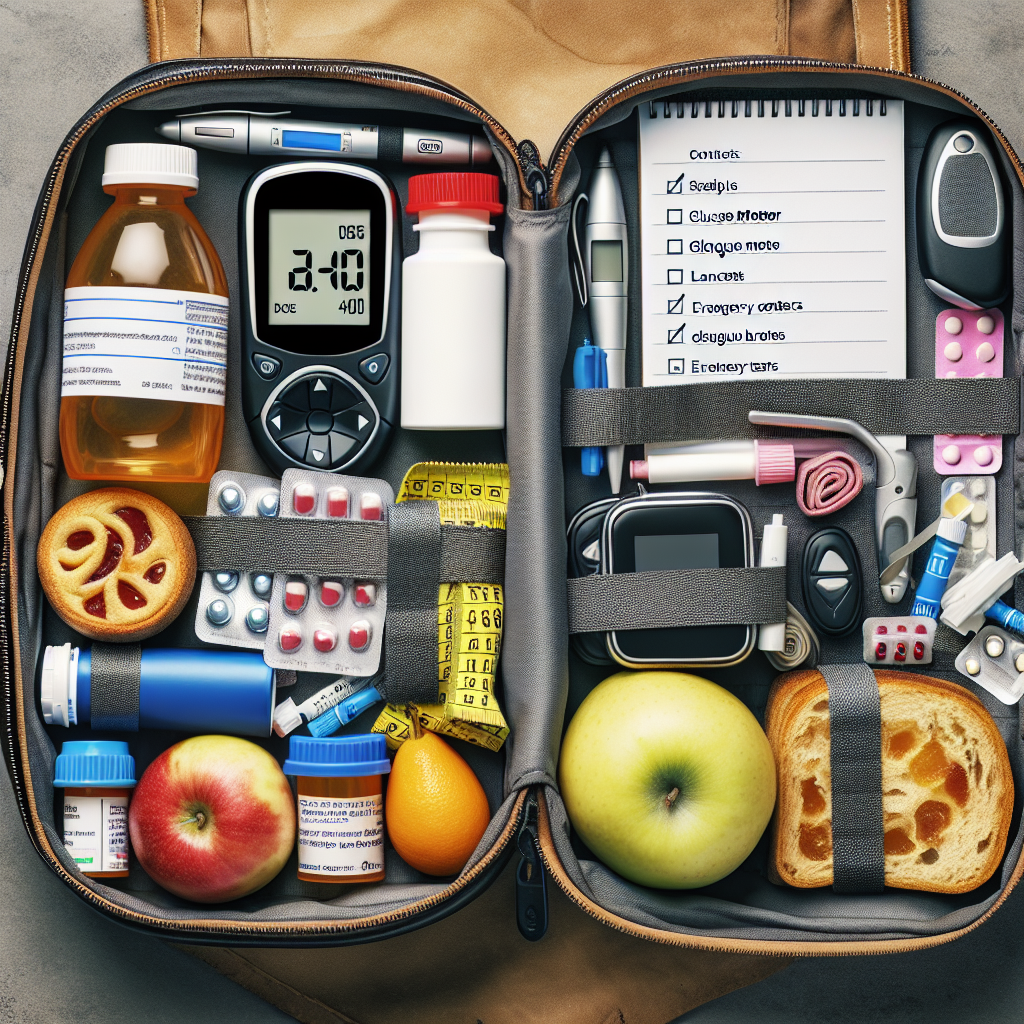If you’re a diabetic traveler, planning and organizing for a trip can be an added challenge. From ensuring you have enough medication supplies to packing travel-friendly snacks, being prepared is key to making your journey smooth and enjoyable. In this article, we present a comprehensive checklist of packing essentials specifically tailored for diabetic travelers. Whether you’re embarking on a weekend getaway or a long-haul adventure, this checklist will ensure you have everything you need to stay healthy and worry-free while on the road. So grab your suitcase and let’s get packing!
Understanding Diabetes and Travel
Knowing the basics about diabetes
Before embarking on any travel plans, it is essential to have a solid understanding of diabetes. Diabetes is a chronic condition that affects how your body regulates blood sugar levels. There are two main types of diabetes – type 1 and type 2. Type 1 diabetes is an autoimmune disease where the body does not produce enough insulin, while type 2 diabetes is characterized by insulin resistance. Both types require careful management and monitoring of blood glucose levels.
Impact of traveling on diabetes
Traveling can impact your diabetes management in several ways. Changes in routines, time zone differences, and new environments can disrupt your regular diabetes care plan. Additionally, access to medical supplies and healthcare services may differ in various travel destinations. It is crucial to be aware of these potential challenges and take appropriate measures to ensure a safe and enjoyable trip.
Preparations needed for diabetic travelers
As a diabetic traveler, you need to prioritize preparations to maintain your health and manage your condition while on the go. This includes arranging for a pre-travel medical checkup, ensuring an adequate supply of prescription medications, packing enough insulin and related supplies, monitoring blood glucose levels regularly, preventing hypoglycemia, making healthy food choices, considering exercise and activities, being prepared for emergencies, and managing stress and sleep. Let’s delve deeper into each of these aspects to ensure a well-rounded approach to your diabetes management while traveling.
Medical Checkup Before Travel
Importance of pre-travel medical checkup
Before embarking on your journey, it is crucial to schedule a medical checkup with your healthcare provider. This allows your doctor to assess your overall health and provide specific recommendations tailored to your individual needs. They can evaluate your diabetes management plan, review your current medications, and advise you on any necessary adjustments based on the upcoming travel conditions.
What to discuss with your doctor
During your pre-travel medical checkup, make sure to discuss the details of your trip with your healthcare provider. Inform them about the duration of your travel, the destinations you plan to visit, and any specific activities you have planned. This information will help your doctor provide personalized advice regarding factors such as changes in insulin dosage, adjustments in meal timing, potential risks, and precautions to take.

Prescription Medications
Sufficient supply of diabetic medications
When traveling, it is vital to ensure that you have an ample supply of your prescribed diabetic medications. Take into account the duration of your trip and potential delays or unexpected circumstances. It is wise to carry extra medication to account for any unforeseen circumstances or travel delays. Packing all necessary medications in your carry-on bag ensures accessibility and minimizes the risk of loss or damage.
Keeping medications safe during travel
Proper storage of medications is crucial during travel. Insulin and other medications should be stored at the appropriate temperature as prescribed by the manufacturer. Ensure that your medications are not exposed to extreme heat or cold. Consider using a travel cooler bag or insulated container to maintain the required temperature range.
Securing necessary prescriptions for travel
To avoid any complications at customs or during security checks, it is advisable to carry your prescriptions with you. Make sure the prescriptions are in the original packaging, clearly labeled with your name, the medication’s name, dosage instructions, and your healthcare provider’s contact information. It is also beneficial to carry a letter from your doctor explaining the necessity of the medications and any associated medical devices.
Insulin and Related Supplies
Packing enough insulin
Insulin is a vital component for many diabetic travelers. It is essential to pack enough insulin to last through your entire trip, accounting for any unexpected delays or changes in dosage requirements. Consider the duration of your journey, the availability of insulin at your destination, and the possibility of emergency situations that may require additional supplies. Packing extra insulin cartridges or vials along with syringes or insulin pens is a prudent approach.
Transporting insulin properly
Insulin must be transported safely to maintain its potency. When traveling by air, pack your insulin in your carry-on bag to prevent exposure to extreme temperatures in the cargo hold. Ensure that your insulin is not stored near ice packs or placed in direct sunlight. It is recommended to use a specialized travel case designed for insulin storage to maintain the appropriate temperature range during transit.
Carrying sufficient insulin supplies
In addition to insulin, it is crucial to carry an adequate supply of insulin-related supplies. This includes extra syringes, pen needles, lancets, glucose test strips, and batteries for glucose meters. These supplies are essential for regular blood glucose monitoring and insulin administration. Having extras ensures that you are prepared for any unexpected situations or equipment malfunctions.

Importance of Blood Glucose Monitoring
Why regular blood glucose checking is crucial
Regular blood glucose monitoring is a critical aspect of diabetes management, especially during travel. Changes in diet, physical activity, time zones, and stress levels can impact your blood sugar levels. Monitoring your blood glucose allows you to make necessary adjustments to your insulin dosage, diet, and lifestyle to maintain optimal control. It provides valuable insights into how your body is responding to various travel factors.
Types of glucose monitors to bring
When traveling, it is advisable to bring a blood glucose monitoring system that is lightweight, portable, and easy to use. There are various types of glucose monitors available, including traditional glucose meters, continuous glucose monitoring (CGM) systems, and flash glucose monitoring systems. Choose the one that suits your preferences and needs. Ensure you have an adequate supply of test strips compatible with your chosen monitor.
How to store and care for your monitor
To ensure accurate and reliable blood glucose readings, it is important to store and care for your glucose monitor properly. Keep it in a protective case or pouch to prevent damage during travel. Avoid exposing your monitor to extreme temperatures, moisture, or direct sunlight. Additionally, regularly clean your monitor according to the manufacturer’s instructions to maintain accuracy and hygienic conditions.
Hypoglycemia Prevention
Understanding hypoglycemia risks for diabetics
Hypoglycemia, or low blood sugar, is a potential risk for diabetic travelers. Changes in meal schedules, increased physical activity, and fluctuations in stress levels can increase the likelihood of hypoglycemic episodes. It is essential to be aware of the symptoms of hypoglycemia, such as dizziness, sweating, confusion, and shakiness, and take proactive measures to prevent its occurrence during your trip.
Packing snacks for preventing hypoglycemia
To prevent hypoglycemia while traveling, packing a variety of healthy snacks is crucial. Opt for snacks that are rich in complex carbohydrates and protein while being low in added sugars. Nut bars, fruit, trail mix, and snack packs of cheese or peanut butter can be excellent choices. Be mindful of portion sizes and make sure to carry snacks with you at all times for quick accessibility.
What to do in case of hypoglycemia
Despite taking preventive measures, it is essential to be prepared for managing hypoglycemia episodes. Always carry a source of fast-acting carbohydrates, such as glucose tablets or gel, in case your blood sugar drops too low. If you experience symptoms of hypoglycemia, take the appropriate amount of glucose to raise your blood sugar levels. Once stabilized, it is advisable to retest your blood glucose and consume a small snack with complex carbohydrates and protein to prevent a subsequent drop.

Healthy Food Choices and Eating Habits
Importance of maintaining healthy eating habits during travel
Maintaining healthy eating habits while traveling can be challenging, but it is crucial to keep your blood sugar levels stable and ensure overall well-being. Strive to make balanced food choices that include a variety of fruits, vegetables, whole grains, lean proteins, and healthy fats. Avoid excessive consumption of sugary and high-carbohydrate foods, as they can lead to blood sugar spikes. Opt for portion-controlled meals that provide adequate nutrition and avoid overindulgence.
Packing nutritious snacks
In addition to monitoring your main meals, packing nutritious snacks is essential for diabetic travelers. Choose snacks that are low in added sugars and provide valuable nutrients. Some excellent options include fresh fruits, raw vegetables, unsalted nuts, and low-fat yogurt. These snacks can provide sustained energy, help maintain stable blood sugar levels, and prevent overeating during your travels.
Choosing diabetic-friendly meals when dining out
While dining out during your travels, it is beneficial to choose diabetic-friendly meals. Look for dishes that include lean proteins, vegetables, and whole grains. Opt for grilled or baked options instead of fried items. Consider inquiring about the ingredients and cooking methods used to ensure that your chosen meal aligns with your dietary needs. Portion control is also crucial, so consider sharing meals or asking for a takeout box to avoid overeating.
Exercise and Activities
Considering physical activities during travel
Engaging in physical activities while traveling is an excellent way to maintain overall health and manage blood sugar levels. Incorporate activities that you enjoy and that fit your fitness level. Walking, hiking, swimming, and cycling are great options. Consider the duration and intensity of the activities and how they may impact your blood sugar levels. It is advisable to carry snacks with you to prevent hypoglycemia during or after exercise.
How exercise impacts blood sugar levels
Exercise can influence blood sugar levels in different ways depending on its duration and intensity. While moderate-intensity exercise can lower blood sugar levels, high-intensity or prolonged exercise can lead to hypoglycemia. Regular monitoring of blood glucose levels before, during, and after physical activities is essential to understand how your body responds to exercise. Adjusting your diabetes management plan accordingly, such as modifying insulin dosage or carbohydrate intake, can help maintain stable blood sugar levels.
Choosing appropriate footwear and clothing for activities
When engaging in physical activities during your travels, it is important to prioritize comfort and safety. Choose appropriate footwear that provides adequate support and cushioning for your chosen activities. If necessary, wear diabetic socks to prevent blisters or irritation. Additionally, dress in comfortable, breathable clothing that allows for freedom of movement and helps regulate body temperature. Remember to protect yourself from the sun by wearing sunscreen, sunglasses, and a hat.

Emergency Preparedness
Carrying an emergency medical ID
When traveling with diabetes, it is crucial to carry an emergency medical ID at all times. This ID should include information about your diabetes diagnosis, any other existing medical conditions, and emergency contact details. Wearing a medical alert bracelet or necklace ensures that first responders or medical professionals can quickly identify your condition and provide appropriate care during emergencies.
Knowing local emergency contacts
Before traveling, research and note down the local emergency contact numbers for your destination. Familiarize yourself with the local healthcare system and locate nearby hospitals or clinics. This knowledge can prove invaluable in case of a medical emergency, as it allows you to seek prompt medical assistance.
Planning for potential health emergencies
While no one wants to anticipate a health emergency, it is wise to be prepared for unexpected situations. Create an emergency plan that includes contact information for your healthcare provider, local emergency services, and your travel companions. Share this plan with trusted individuals and ensure they are aware of your medical condition and any specific needs. Having an emergency kit with essential supplies such as band-aids, antiseptic wipes, and over-the-counter pain relievers can also be beneficial.
Managing Stress and Sleep
Effects of stress and poor sleep on blood glucose
Stress and poor sleep can significantly impact blood glucose levels. When traveling, it is common to experience stress due to unfamiliar environments, itinerary changes, or language barriers. Additionally, disrupted sleep patterns can affect insulin sensitivity and lead to difficulties in managing blood sugar levels effectively. Recognizing the impact of stress and poor sleep is essential for diabetic travelers to devise strategies for stress management and establish healthy sleep routines.
Managing sleep disturbances while traveling
To optimize sleep while traveling, establish a consistent sleep routine and ensure you have a comfortable sleeping environment. Consider bringing items that can help create a sleep-conducive atmosphere, such as an eye mask, earplugs, or a travel-sized pillow. Minimize exposure to electronic devices and bright lights before bed to promote better sleep quality. If necessary, consult with your healthcare provider about potential strategies or medications that can aid in improving sleep during your travels.
Relaxation techniques for stress management
Stress management is crucial for maintaining stable blood sugar levels and overall well-being while traveling. Incorporate relaxation techniques into your daily routine to mitigate the effects of stress. Deep breathing exercises, meditation, yoga, and listening to soothing music can all help alleviate stress levels. Additionally, engaging in activities that bring you joy and provide a sense of relaxation, such as reading, painting, or exploring nature, can be beneficial for managing stress.
By understanding the basics of diabetes, taking necessary precautions, and implementing effective strategies for diabetes management, you can ensure a successful and enjoyable travel experience. Remember to consult with your healthcare provider for personalized advice and make the necessary preparations to maintain optimal control of your diabetes while exploring the world. Safe travels!


